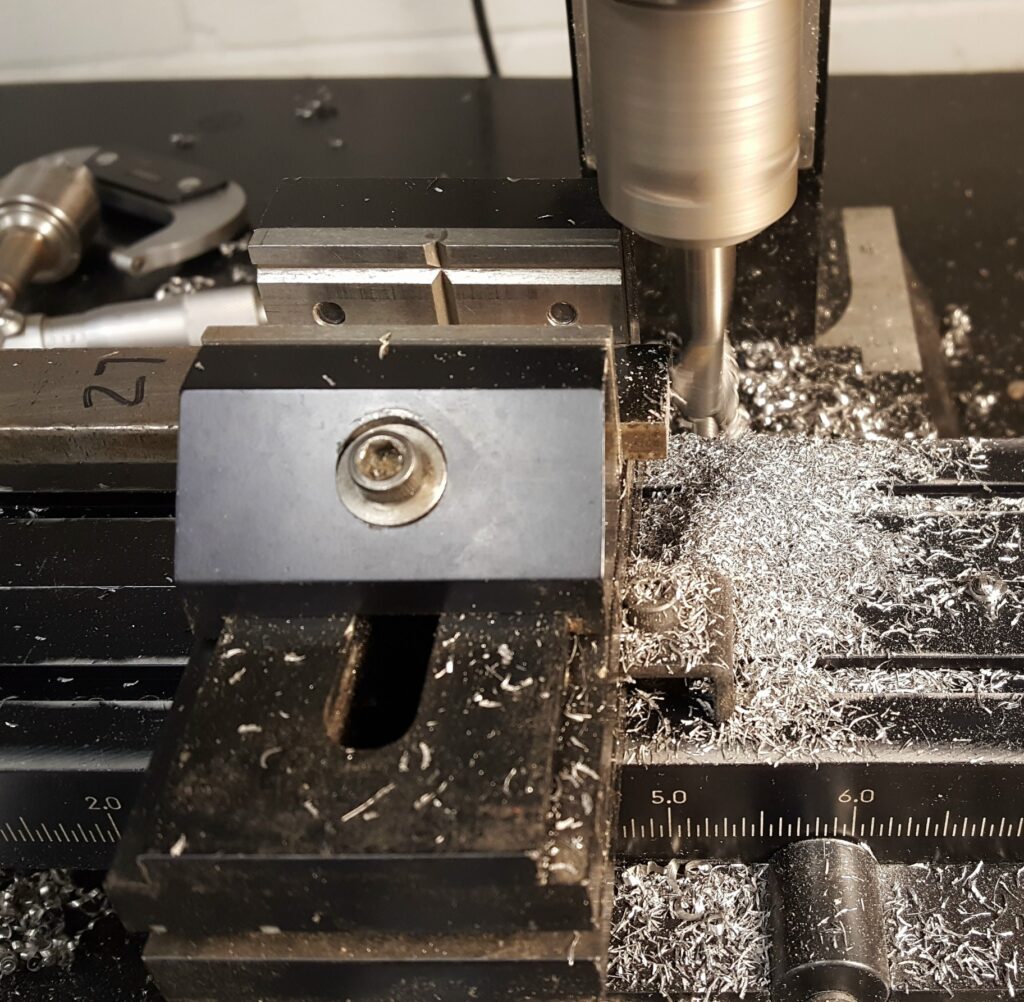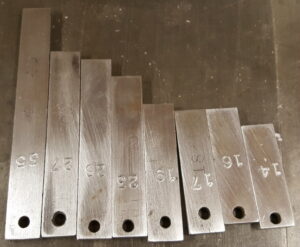I was cleaning up the workshop a bit last week and ran across a small project which had fallen by the wayside.
As part of all the Monotype parts I had collected, there was a random assortment of line length gauges. These are used to set the galley width on the Composition Caster to a specific measure, and to do so more accurately than by eyeballing it off the scale or even using a piece of reglet.
The set I had was very incomplete and also contained several duplicates, so the project I had set myself was to shorten some of the duplicates to fill in some of the missing lengths.
These are not the “official” Point Measure Gauge set (8CT7) that were listed with some of the Monotype tools in the English Spare Parts List. Peering at the photo in this book, it appears that the gauges they provided were in round lengths, and you were expected to stack together the correct ones to form the desired measure. The set appears to contain two 20’s, one 10, one 6, two 4’s, and several smaller ones, likely 2, 1, and ½ pica. Monotype actually produced four such sets, based on the pica standard: 0.166, 0.1667, 0.1776, or 0.1653 inches per pica, with the first being the one used for Lanston Monotype systems.
Measuring the gauges I had implied that they were made to the 0.1667 standard, so they would set the galley about 0.4% wider, or about 1 point on an 18-pica line, relative to how the rest of the caster measures things.
For consistency I chose to stick to this standard even though the 0.166-inch standard might be more appropriate with the Monotype.
The job was a simple matter of milling some metal off the end of some of the gauges, after having marked in felt tip what the desired length was. In retrospect I should have marked them in inches as well as there was one I thought I had completed but I had cut to 3.866″ rather than 3.833″. Fortunately this mistake was the right way and I just had to trim off a bit more metal.
In retrospect I should have marked them in inches as well as there was one I thought I had completed but I had cut to 3.866″ rather than 3.833″. Fortunately this mistake was the right way and I just had to trim off a bit more metal.
The pieces that needed more than one pica trimmed off were rough-cut short on a bandsaw first. I had thought that a gauge that only needed one pica trimmed off could just be milled, but my mill is only powerful enough to take off 0.020″ (0.5mm) at a pass so I quickly decided that even removing a single pica needed the band-saw treatment to start.
I de-burred and polished up the gauges on my belt sander, and stamped them with their new lengths. The sanding also removed some but not all of the original stamped lengths. The new stamping was deep enough that I decided to forego grinding off the old markings completely, as it would have taken too long and removed too much metal. It turns out my newly stamped numbers were prominent enough that I think I can avoid any confusion.
The sanding also removed some but not all of the original stamped lengths. The new stamping was deep enough that I decided to forego grinding off the old markings completely, as it would have taken too long and removed too much metal. It turns out my newly stamped numbers were prominent enough that I think I can avoid any confusion.
Here’s the entire set, including the ones I didn’t touch, the longest being 48½ picas.
 I now see I still have a duplicate 22-pica gauge, so I might shorten that one to 20. The set is still grossly incomplete, especially if half-pica lengths are desired, and I could make more from new ¼×¾″ steel stock but I’m not sure I have enough use for them to warrant the effort.
I now see I still have a duplicate 22-pica gauge, so I might shorten that one to 20. The set is still grossly incomplete, especially if half-pica lengths are desired, and I could make more from new ¼×¾″ steel stock but I’m not sure I have enough use for them to warrant the effort.
I also have one other gauge that I’m (mis-)using as a spacer when mounting an English display mould on my caster. This mould’s base is about ¼″ smaller front-to-back than the Lanston moulds, and so a spacer is required for the front mould clamp (89E1 on Lanston casters, Xa48E on English casters, and no, I don’t know which one I actually have) to hold the mould in position. I will probably find some other piece of ¼″ steel to use as this spacer (and stamp on it what it is so it doesn’t go astray), and add the line gauge (probably shortened and re-labelled) to my collection.

Leave a Reply